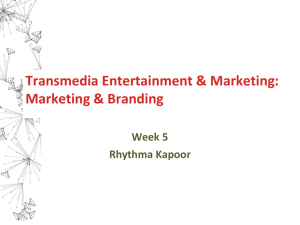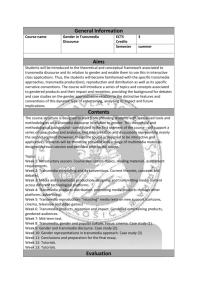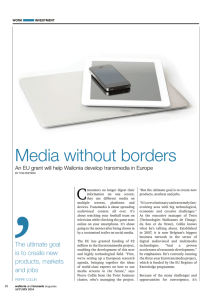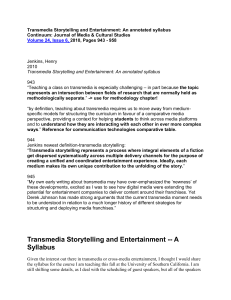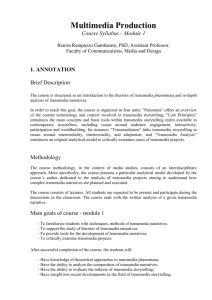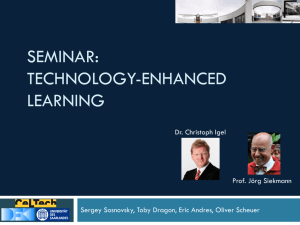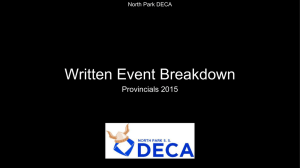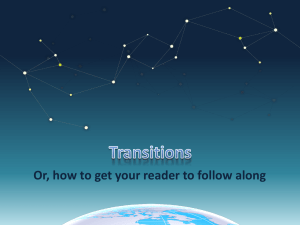Sliding
advertisement
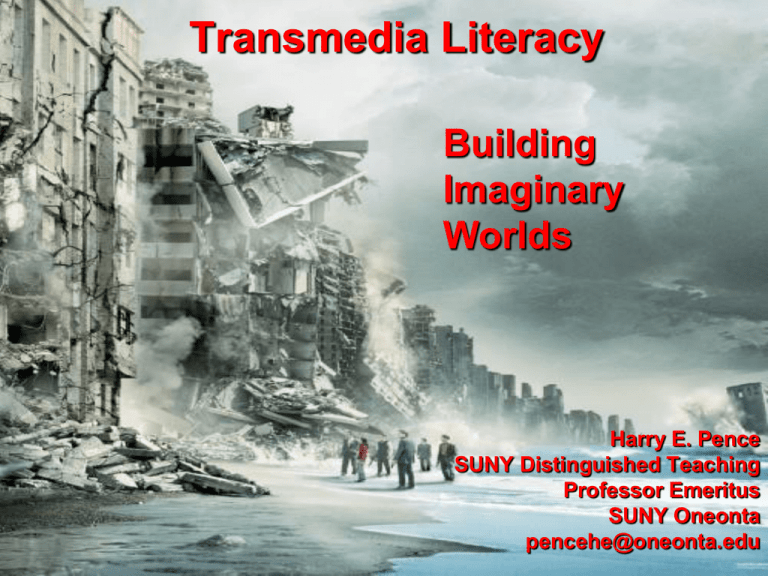
Transmedia Literacy Building Imaginary Worlds Harry E. Pence SUNY Distinguished Teaching Professor Emeritus SUNY Oneonta pencehe@oneonta.edu Actually, transmedia is just the newest of the unusual narrative forms. The Choose Your Own Adventure series of children's books were published by Bantam Books from 1979-1998. The reader chose what actions the main character would take. Michael Joyce's Afternoon, a story, (1987) is generally considered one of the first hypertext fictions. The Cave of Time, the first Choose Movies, like Memento (2000) and Sliding Your Own Doors (1998), have played with the idea Adventure book. of nonlinear time flow. Many of you can probably list other examples of this. Transmedia is a logical outgrowth of: Fanzines, fan-produced publications that attempted to fill in the gaps of a commercial product. The popularity of alternate reality games (ARG), like “The Beast (2001)” a promotional tool for the film A.I.: Artificial Intelligence. The popularity of Web 2.0 (blogs, wikis, etc.) The increasing integration of the media industries. See “Walt Disney University” by Josh Kim http://tinyurl.com/382y4de Christy Dena argues that, “Transmedia practices are not just the concern of conglomerates who are horizontally organized, but also of individuals with limited resources.” Behnam Karbassi says, “Kids are already porting content from one screen to another, blurring the lines of media.” According to a 2005 study conducted by the Pew Internet and American Life project, more than one-half of all American teens—and 57 percent of teens who use the Internet—could be considered media creators. http://tinyurl.com/2b6o47u http://www.pewInternet.org/PPF/r/166/report_display.asp Evolution of Transmedia Multimedia refers to a mix of text, images, video, and sound within a single platform. Dana Goodyear writes about the cell-phone novel, or keitai shosetsu, the first literary genre to emerge from the cellular age. An effort to encourage similar works in the U.S. is called Figment. http://tinyurl.com/9wcrgw “Distributed narratives don’t just bring media together but rather expand the narrative across media, through the network and sometimes into the physical spaces that we live in.” Jill Walker From Implementation, a sticker novel by Nick Montfort and Scott Rettberg. According to Henry Jenkins, The Matrix Franchise is a true Transmedia Story. InThe Matrix franchise, information is communicated through three live action films, a series of animated shorts, two comic books, and several video games. See Convergence Culture, Chap 3 http://tinyurl.com/3xfhl27 Henry Jenkins has described the characteristics of the transmedia aesthetic. http://tinyurl.com/37u3okq 1. A shift from a focus on individual characters and their stories towards ever more complex forms of world building. 2. The expansion of traditional forms of seriality that disperse story information across multiple chunks of entertainment content. 3. A focus on layered or multiple forms of subjectivity where we experience the story through the perspective of multiple characters, who often reflect different values or social situations. This is a major shift in the way the we experience media. Carlos Scolari (University Pompeu Fabri, Barcelona, Spain) says that the “reader’ of transmedia must be accustomed to: Interactivity Networks Screen fragmentation More rapid presentation Rapid adaptation to new Interfaces Intertextuality Multi-screens I would add that the responsibility for making meaning is shared by the author and the reader. Karbassi and Thompson describe three types of transmedia projects: franchise, marketing, and native. http://tinyurl.com/22nn6oy I found it easier to think in terms of who has control. Experience transmedia: an individual or group uses various media platforms to create a unified experience. Framework transmedia: an existing world or brand is adapted by users to create interlocking but independent visions of that world. No single author (or group) has control. Examples of experience transmedia. Majestic (2001) is the classic alternate reality game (ARG); there is no separation between the in-game and out-of-game experiences. It used phone, instant messages, e-mail, and fax. Valemont is the MTV transmedia murder mystery which occurs on TV, blogs, Facebook, phones, and web sites. Framework Transmedia requires not just a plot and characters, but a whole world that is designed to be incomplete. This world then interacts socially with a networked culture to create opportunities for exploration, interpretation, and expansion. World without Oil is a massively collaborative vision of the first 32 weeks of an oil crisis, based on 1,500 blogs, images, and videos. What skills will patrons need to participate in a transmedia world? Transmedia literacy requires familiarity with a variety of different platforms. Flickr Twitter Media Sharing FaceBook Social Networks SlideShare LlinkedIn YouTube Hulu Podcasts My Media Pandora Environments NetVibes Delicious Diigo Aggregators Virtual Worlds Second Life This diagram should also include both blogs and online gaming site. Henry Jenkins has defined an extensive set of Transmedia Literacy skills. http://www.teachstory.org/?p=535 I am thinking of a simpler set of skills: the ability to search for, remix, and distribute information on various media platforms, the ability to create independently within an integrated vision, the ability to represent ideas using a combination of images and text, and The ability to make effective use of reading from a screen. Anne Cranny-Francis says the multimodal environment implies not only new technologies but also new cultural practices. Information storage is no longer just about text. Web page design is becoming a critical skill (?). Links define reading differently than footnotes. It is not either/or, text vs. image literacy, but rather both, as well as how they interact. Chap. 6,“Connexions”, Anne Cranny-Francis, (pg 135-174) Cyberlines 2.0: Languages and Cultures of the Internet, Donna Gibbs and Kerri-Lee Krause, James Nicholas Publishers, Albert Park, Australia, 2006. Joshua Kim predicts that curricular content will be consumed in shorter chunks, by more nontraditional students, across multiple times and places. This certainly sounds like transmedia! Recently, I heard a rep from Pearson say that in five years they expect that only ten percent of their income will come from traditional book publications. A host of sites is available that offer academic videos and video articles. Journals are also moving toward mixed media, with video articles. How will these be integrated into the library holdings? Fluidity of Knowledge Transmedia narratives often seem to provide incomplete information. They can change as we are looking at them. The reader must not only adjust to fragmented information space, but also to distributed media spaces. How does transmedia affect the library? Concept for Stockholm library http://tinyurl.com/yd8go22 How can you tie together these different platforms in a catalog? Many components of transmedia are ephemera. By definition, transmedia assumes that traditionally separate media are coequal. Moving from atoms to electrons for information storage offers new cataloging options! Assume “Everything is Miscellaneous!” David Weinberg Typically, courses in Art or Communications seem more likely to integrate transmedia literacies into the classroom. Blandy and Fenn have created a transmedia course using student groups. (AAD 450 / 550: Art and Society). Here is the syllabus. http://tinyurl.com/387hzzc Inanimate Alice is designed to introduce teachers and students to new media literacies. http://www.inanimatealice.com /education/ A free pedagogy pack is available. Elsevier is already reimagining the journal article with The Article of the Future project. http://tinyurl.com/33cb4td The Elsevier spokesman points out that despite being online current science articles are still print-based (though we call it a PDF); still require linear reading, and don’t change based on the intended use of the reader. They are experimenting with Tabs allow the reader to configure the article to focus on just figures and data, the experimental results, or just skim, A Graphical Abstract are already becoming common, Supplementary data only appears when the reader chooses to see it. The nature of links is changing. For example, see a free program called apture (www.apture.com). It lets you look up content without ever leaving a page. And you can paste the information into the document. Imagine what this could do in a textbook. With special glasses a book can become a transmedia object. A drawing can spring from the page into 3D. Virtual tabs “Reading in a whole new way.” by Kevin Kelly http://tinyurl.com/35w4pws Moving between transmedia narratives require real time mental adjustments! Will MS Kinect have us scanning a database with gestures like a symphony conductor? A closing thought: “We are definitely at moment of transition, a moment where an old media system is dying and a new media system is being born.” Henry Jenkins Thank you for listening. Are there any questions or comments? Some references for those who want to learn more about transmedia. Convergence Culture by Henry Jenkins is still the classic. “Hyper and Deep Attention: The Generational Divide in Cognitive Modes” N. Katherine Hayles, Profession 2007, pp. 187–199 (13) Christy Dena expands transmedia practices beyond the commercial franchise model. http://www.christydena.com/academic-2/phd/ Jill Walkers article on distributed narratives provides an interesting background to talk about transmedia. http://tinyurl.com/2fkre6t
